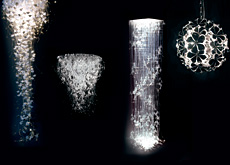
Sharon Marston’s collection of chandeliers mix fibre optic technology with a range of materials forming lights that produce stunning effects. The Black Lotus chandelier from UK-based Rainbow
Others claim that chandeliers bring an artistic value to an area in the same way as paintings or ornaments, bringing the rest of the architecture into focus. "Chandeliers are gorgeous functional works of art. They are often referred to as the jewellery of a building," says Laura Loomis of Charles Loomis. "They attract people's attention, draw them into a space and positively influence their perception of being in a special place. People are naturally attracted to glass and light and chandeliers can bring a sparkle and energy as well as luxury to an otherwise mediocre environment." It is important that a chandelier works as a piece of art even when it is not lit.
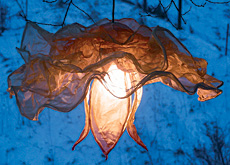
Custom-made chandeliers from Fire Farm are made from a range of different materials.
So what are the current trends, if any in the world of the contemporary chandelier? Chandelier designer Nora De Rudder believes there are two clear paths where the use of materials are concerned. "There are different trends for chandeliers at the moment. There are the industrial trends with materials such as metals and man-made materials such as polyester. And then you have the artistic and organic trend which seems to be popular at the moment, which uses a lot of different materials, such as paper, wood, copper and porcelain." De Rudder's almost gothic-like designs take the latter route using materials such as mussel shells, pearls, glass and feathers. "As my work is more artistic I get my inspiration from life and nature itself as well as different cultures," she adds.

Swarovski crystal chandeliers are some of the most famous in the world.
If making chandeliers from feathers wasn't enough, there is a company that designs chandeliers made from silk. American-based company, Aqua Creation's marine-inspired structures are made of treated crushed Indian silk - that is resistant to mould and fire - felt and pure wool, as well as fine colourful chamois leather, velvet or corduroy textures laid over metal structures. "This use of silk is perhaps the most interesting use of material at the moment in the world of chandeliers," admits Hans Bruinsma of Caspaiou, distributors of Aqua Creations in Dubai.
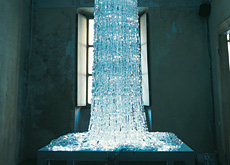
Swarovski crystal chandeliers are some of the most famous in the world.
Fire Farm is a company that concerns itself with interaction of light and different materials. This means that a range of different materials are explored including metal mesh, stainless steel wire cloth, paper, glass, hemp muslin and Dupioni silks to name but a few. "We revealed some new designs recently at a design event in America, including mixtures of dichroic diffusers with finely woven stainless steel wire cloth that has the ethereal presence of smoke or jellyfish tendrils," explains Pollock. "We also married dichroic film with mylar to get entirely new effects. These items we showed were less about the product form being presented and more about the possibilities these materials offer." The company has an established product line with set colour options that can be modified if desired but also works with designers to help them create conceptualised chandeliers. "We just start engaging materials directly and see where they take us, creating works that are more akin to sculpture with light than lighting fixtures," adds Pollock.
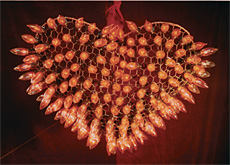
Nora De Rudder’s Small Flames Heart.
In terms of shapes, it seems that flowery designs are making their presence felt, with many companies using nature for inspiration in their designs, as Wayne Iu from Rainbow Lighting admits: "There is a clear influence of floral designs creating a look that is reminiscent of the 60s and 70s. Rainbow's own Lotus chandelier is inspired by bouquets of flowers. Each flower is handmade in Murano glass and comes in three sizes."

Belle Mead Hot Glass.
Charles Loomis is another company that is producing chandeliers with a floral theme. Dahlia is a chandelier that was inspired by its namesake flower. Made from hand-formed sheer embossed crystalline glass and polished stainless steel it comes in a variety of different colours, textures and metal finishes.
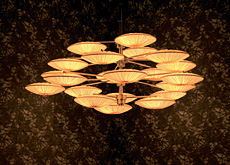
Aquatic style lighting from Aqua Creations.
Designed by Marcello Furlan, Blum from Axo Light is a collection of blown glass and metal chandeliers that are reminiscent of dandelions. A number of glass vases burst out of the chrome-plated metal sphere forming a blossom of crystal. Each vase contains a single bulb that lights its edge resulting in diffused light without an unpleasant glare. The light is available in 31-bulb, 19-bulb or single bulb versions.
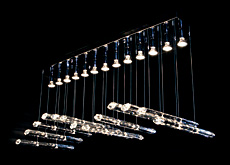
Adamas Piano from Rainbow’s Essence collection.
Following on this organic theme is jGoodDesign, an American company that makes environmentally-friendly chandeliers. The shapes are inspired from ocean waves and aquatic life. Its unique shaped Astral chandelier is made from aluminium, that is hand-brushed and free from plating or anodising, and partially recycled hand-blown glass. The company's Lily Pendant chandelier is inspired by floating lily pads and is available with interchangeable incandescent or low energy LED lighting bulbs.
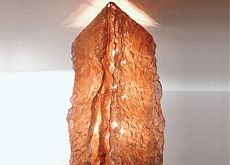
Fire Farm.
But it's not all about organic shapes and floral designs. The geometric shape is making its presence felt with many companies investing in crystal cut into sleek designed shapes. Rainbow's Adamas range from its Essence collection creates spectacular lighting effects from suspended pieces of cut crystal. The illusion it creates is of floating crystal forms refracting light shining on it from above.
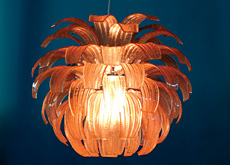
Charles Loomis’ Dahlia follows the current floral trend.
Installing chandeliers can be a tricky operation, especially given their incredible weight and often enormous size. "The first thing you have to think about is safety," warns Iu. "Making sure that the ceiling structure is suitable for chandelier fittings is paramount, as chandeliers can easily weigh over 50kgs." Forward planning is also something that should not be overlooked if expenses are to be kept to a minimum further down the line, according to Pollock. "Early planning and cohesive interior design allows for the developer to account for specific engineering and safety requirements early in the construction phase when those modifications are at their least expensive. The addition of reinforced suspension points and features such as chandelier lifts early in construction allow for easier installation and cheaper long-term maintenance," he says. If a chandelier is being installed into an existing property it is also essential to know if it can be linked directly to with the existing electrical system.
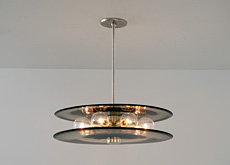
JGoodDesign.
Lighting designer Beau McClellan also stresses that scale is often a problem when choosing the right chandelier. He says: "One thing interior and lighting designers seem to have a problem with is scale. Off the shelf a chandelier can look extremely large when hanging at a low level surrounded by other chandeliers. However, the same chandelier can look miniscule when hanging in a huge reception hall."
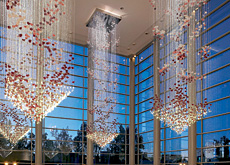
Sharon Marston chandeliers in the Hilton in Warsaw.
Technology with regards to chandeliers is also something that has also experienced some interesting changes over the last few years. However it still appears that the most common form of light source for chandeliers is the incandescent light bulb. "Interior designers and lighting designers continue to prefer incandescent lamps for chandeliers because of their warmth, availability, low cost and sparkle. Fluorescent lamps do not provide sparkle but can be used to produce a warm glow if installed behind opaque or sand glass," says Loomis. But with the world slowly turning its back on the environmentally unfriendly and energy intensive incandescent light bulb - Australia is set to ban it in 2010 with Canada in 2012, while the European Union is proposing a ban for the near future - what alternatives are being considered for its replacement? Famously used as light guides in medical operations or quirky decorations for Christmas trees, the fibre optic is now being used as an alternative light source thanks in part to designers like London-based Sharon Marston. Using materials like woven nylon, iridescent PVC, mono-filament and stainless steel along with fibre optics, Marston has produced some outstandingly creative pieces of bespoke lighting. Her Autumn light is a cascading mass of colour and light, woven with PVC and mono-filament to create a spiraling light based on a seasonal palette of fiery autumnal shades. The designer uses two fibre optics in her work. The bare thread polymer and glass side emitting, which she claims are both quite different to work with, each giving a different effect. "The options of a single colour, or a series of colours creating animation, which can then be programmed to different speed, adds to the diversity of the medium," she explains.
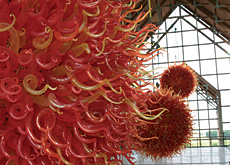
Belle Mead Hot Glass chandeliers are made from hand blown glass.
Now that there is a warm white light available, everyone is talking about LEDs as the lighting source of the future. The downside is their expense and the technology that is still being developed at a rapid pace, meaning that there are no assurances that replacement lamps will be available when the original fails in 15 years or so. Having said that Pollock believes the merits of the LED are unquestionable. He explains: "LED is the most promising source of illumination that is now becoming practically available. It brings the promise of extremely long bulb life and minimal energy consumption and toxic waste. It also has enormous design freedom due to the minimal wire, heat and size requirements compared to other available technologies."
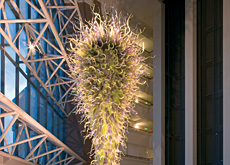
Belle Mead Hot Glass chandeliers are made from hand blown glass.
McClellan, who uses LED technology in all his bespoke chandeliers, agrees that the benefits of this modern light source are huge. "Anybody that has a large traditional chandelier will tell you how annoying it is when you have to change a bulb," he says. "LEDs can now be guaranteed to last between 60,000 to 100,000 hours, so no more changing light bulbs." However, it is worth considering that the transformers used to drive the LEDs should be mounted somewhere accessible as they are more liable to fail than the LEDs. McClellan also highlights the benefits of introducing colour to chandeliers through the use of LEDs but warns against unattractive mixes of colour. "Another great advantage is the possibility to introduce colour to your chandelier. But you should be careful here as the red/green/blue LEDs that are used as the palette to mix colour can be very tacky. Unless you want the space to look like a Vegas casino, it is important that the colour is controlled and diffused properly. If you get the control right, the effects can be stunning," he says.
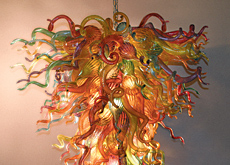
Belle Mead Hot Glass.
With so many materials and designs available there has never been such an interesting time to invest in a chandelier as a lighting option. "At the moment, it feels like there are more materials than time to explore, it's very exciting. We are entering a period of great opportunity for creative lighting expression," Pollock concludes.
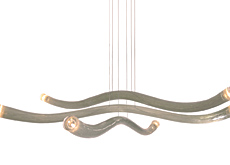
Astral chandelier from JGoodDesign.
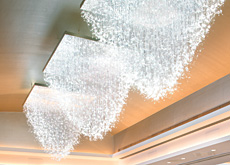
Sharon Marston in the Carton House Hotel, Ireland.
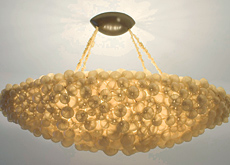
Aqua Creation’s Blondie Bee.

Sharon Marston’s Autumn.
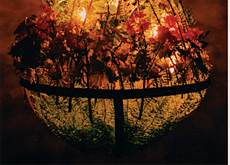
Nora De Rudder’s Baroque chandelier is made from a range of different materials.
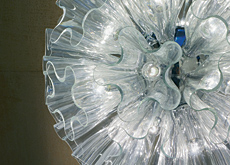
Blum from Axo Light is reminiscent of a dandelion.
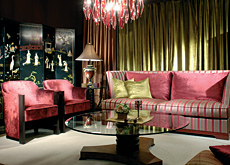
Belight’s range of chandeliers from Brand van Egmond.
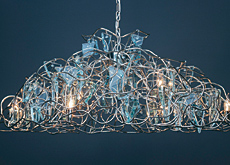
Belight’s range of chandeliers from Brand van Egmond.
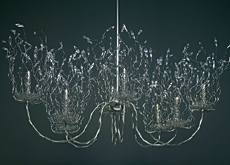
Belight’s range of chandeliers from Brand van Egmond.
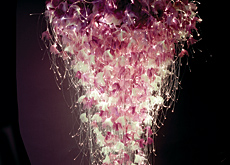
Flight from Sharon Marston.



![A Tranquil Jungle House That Incorporates Japanese Ethos [Video]](https://asean2.ainewslabs.com/images/22/08/b-2ennetkmmnn_t.jpg)









